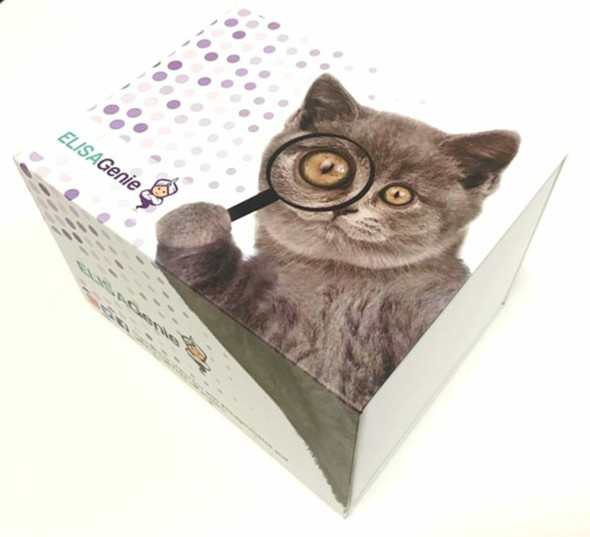Human F10 (Coagulation Factor X) ELISA Kit (HUES01903)
- SKU:
- HUES01903
- Product Type:
- ELISA Kit
- Size:
- 96 Assays
- Uniprot:
- P00742
- Sensitivity:
- 56.25pg/mL
- Range:
- 93.75-6000pg/mL
- ELISA Type:
- Sandwich
- Synonyms:
- Factor X,eponym Stuart-Prower factor,prothrombinase,F10, FX, FXA
- Reactivity:
- Human
- Sample Type:
- Serum, plasma and other biological fluids
- Research Area:
- Cardiovascular
Description
Human F10 (Coagulation Factor X) ELISA Kit
The Human F10 (Coagulation Factor X) ELISA Kit is a highly sensitive and specific assay designed for the precise quantitative measurement of Coagulation Factor X levels in human samples including serum, plasma, and cell culture supernatants. This kit offers reliable and reproducible results, making it perfect for a variety of research applications.Coagulation Factor X is a critical component of the blood clotting cascade, playing a crucial role in hemostasis. Dysregulation of Factor X activity can lead to various bleeding disorders and thrombotic diseases.
Therefore, accurate measurement of Factor X levels is vital for understanding these conditions and developing effective clinical interventions.The Human F10 (Coagulation Factor X) ELISA Kit from Assay Genie provides researchers with a powerful tool to study the role of Factor X in health and disease. With its high performance and ease of use, this kit is a valuable resource for scientists working in the fields of coagulation, thrombosis, and hemostasis.
| Assay type: | Sandwich |
| Format: | 96T |
| Assay time: | 4.5h |
| Reactivity: | Human |
| Detection Method: | Colormetric |
| Detection Range: | 93.75-6000 pg/mL |
| Sensitivity: | 56.25 pg/mL |
| Sample Volume Required Per Well: | 100µL |
| Sample Type: | Serum, plasma and other biological fluids |
| Specificity: | This kit recognizes Human F10 in samples. No significant cross-reactivity or interference between Human F10 and analogues was observed. |
This ELISA kit uses Sandwich-ELISA as the method. The micro ELISA plate provided in this kit has been pre-coated with an antibody specific to Human F10. Standards or samples are added to the appropriate micro ELISA plate wells and combined with the specific antibody. Then a biotinylated detection antibody specific for Human F10 and Avidin-Horseradish Peroxidase (HRP) conjugate are added to each micro plate well successively and incubated. Free components are washed away. The substrate solution is added to each well. Only those wells that contain Human F10, biotinylated detection antibody and Avidin-HRP conjugate will appear blue in color. The enzyme-substrate reaction is terminated by adding Stop Solution and the color turns yellow. The optical density (OD) is measured spectrophotometrically at a wavelength of 450 nm ± 2 nm. The OD value is proportional to the concentration of Human F10. The concentration of Human F10 in samples can be calculated by comparing the OD of the samples to the standard curve.
| UniProt Protein Function: | F10: Factor Xa is a vitamin K-dependent glycoprotein that converts prothrombin to thrombin in the presence of factor Va, calcium and phospholipid during blood clotting. Defects in F10 are the cause of factor X deficiency (FA10D). A hemorrhagic disease with variable presentation. Affected individuals can manifest prolonged nasal and mucosal hemorrhage, menorrhagia, hematuria, and occasionally hemarthrosis. Some patients do not have clinical bleeding diathesis. Belongs to the peptidase S1 family. |
| UniProt Protein Details: | Protein type:Secreted, signal peptide; EC 3. 4. 21. 6; Secreted; Motility/polarity/chemotaxis; Lipid-binding; Protease Chromosomal Location of Human Ortholog: 13q34 Cellular Component: endoplasmic reticulum lumen; extracellular region; Golgi lumen; plasma membrane Molecular Function:phospholipid binding; protein binding; serine-type endopeptidase activity Biological Process: blood coagulation; blood coagulation, extrinsic pathway; blood coagulation, intrinsic pathway; ER to Golgi vesicle-mediated transport; peptidyl-glutamic acid carboxylation; positive regulation of cell migration; positive regulation of protein kinase B signaling cascade; signal peptide processing Disease: Factor X Deficiency |
| NCBI Summary: | This gene encodes the vitamin K-dependent coagulation factor X of the blood coagulation cascade. This factor undergoes multiple processing steps before its preproprotein is converted to a mature two-chain form by the excision of the tripeptide RKR. Two chains of the factor are held together by 1 or more disulfide bonds; the light chain contains 2 EGF-like domains, while the heavy chain contains the catalytic domain which is structurally homologous to those of the other hemostatic serine proteases. The mature factor is activated by the cleavage of the activation peptide by factor IXa (in the intrisic pathway), or by factor VIIa (in the extrinsic pathway). The activated factor then converts prothrombin to thrombin in the presence of factor Va, Ca+2, and phospholipid during blood clotting. Mutations of this gene result in factor X deficiency, a hemorrhagic condition of variable severity. Alternative splicing results in multiple transcript variants encoding different isoforms that may undergo similar proteolytic processing to generate mature polypeptides. [provided by RefSeq, Aug 2015] |
| UniProt Code: | P00742 |
| NCBI GenInfo Identifier: | 119761 |
| NCBI Gene ID: | 2159 |
| NCBI Accession: | P00742. 2 |
| UniProt Secondary Accession: | P00742,Q14340, |
| UniProt Related Accession: | P00742 |
| Molecular Weight: | 54,732 Da |
| NCBI Full Name: | Coagulation factor X |
| NCBI Synonym Full Names: | coagulation factor X |
| NCBI Official Symbol: | F10 |
| NCBI Official Synonym Symbols: | FX; FXA |
| NCBI Protein Information: | coagulation factor X |
| UniProt Protein Name: | Coagulation factor X |
| UniProt Synonym Protein Names: | Stuart factor; Stuart-Prower factor |
| Protein Family: | F107 fimbrial protein |
| UniProt Gene Name: | F10 |
| UniProt Entry Name: | FA10_HUMAN |
As the OD values of the standard curve may vary according to the conditions of the actual assay performance (e. g. operator, pipetting technique, washing technique or temperature effects), the operator should establish a standard curve for each test. Typical standard curve and data is provided below for reference only.
| Concentration (pg/mL) | O.D | Average | Corrected |
| 6000 | 2.383 2.411 | 2.397 | 2.342 |
| 3000 | 1.594 1.622 | 1.608 | 1.553 |
| 1500 | 0.941 0.929 | 0.935 | 0.88 |
| 750 | 0.415 0.453 | 0.434 | 0.379 |
| 375 | 0.245 0.219 | 0.232 | 0.177 |
| 187.5 | 0.163 0.153 | 0.158 | 0.103 |
| 93.75 | 0.102 0.114 | 0.108 | 0.053 |
| 0 | 0.052 0.058 | 0.055 | -- |
Precision
Intra-assay Precision (Precision within an assay): 3 samples with low, mid range and high level Human F10 were tested 20 times on one plate, respectively.
Inter-assay Precision (Precision between assays): 3 samples with low, mid range and high level Human F10 were tested on 3 different plates, 20 replicates in each plate.
| Intra-assay Precision | Inter-assay Precision | |||||
| Sample | 1 | 2 | 3 | 1 | 2 | 3 |
| n | 20 | 20 | 20 | 20 | 20 | 20 |
| Mean (pg/mL) | 293.50 | 822.90 | 2604.90 | 289.80 | 762.40 | 2594.10 |
| Standard deviation | 16.40 | 41.10 | 101.60 | 16.20 | 34.30 | 96.00 |
| C V (%) | 5.59 | 4.99 | 3.90 | 5.59 | 4.50 | 3.70 |
Recovery
The recovery of Human F10 spiked at three different levels in samples throughout the range of the assay was evaluated in various matrices.
| Sample Type | Range (%) | Average Recovery (%) |
| Serum (n=5) | 89-101 | 96 |
| EDTA plasma (n=5) | 88-102 | 94 |
| Cell culture media (n=5) | 87-102 | 94 |
Linearity
Samples were spiked with high concentrations of Human F10 and diluted with Reference Standard & Sample Diluent to produce samples with values within the range of the assay.
| Serum (n=5) | EDTA plasma (n=5) | Cell culture media (n=5) | ||
| 1:2 | Range (%) | 91-103 | 92-104 | 91-105 |
| Average (%) | 98 | 98 | 98 | |
| 1:4 | Range (%) | 98-115 | 80-91 | 92-106 |
| Average (%) | 107 | 86 | 99 | |
| 1:8 | Range (%) | 96-108 | 83-97 | 93-105 |
| Average (%) | 101 | 89 | 99 | |
| 1:16 | Range (%) | 97-111 | 84-96 | 92-107 |
| Average (%) | 103 | 90 | 98 |
An unopened kit can be stored at 4°C for 1 month. If the kit is not used within 1 month, store the items separately according to the following conditions once the kit is received.
| Item | Specifications | Storage |
| Micro ELISA Plate(Dismountable) | 8 wells ×12 strips | -20°C, 6 months |
| Reference Standard | 2 vials | |
| Concentrated Biotinylated Detection Ab (100×) | 1 vial, 120 µL | |
| Concentrated HRP Conjugate (100×) | 1 vial, 120 µL | -20°C(shading light), 6 months |
| Reference Standard & Sample Diluent | 1 vial, 20 mL | 4°C, 6 months |
| Biotinylated Detection Ab Diluent | 1 vial, 14 mL | |
| HRP Conjugate Diluent | 1 vial, 14 mL | |
| Concentrated Wash Buffer (25×) | 1 vial, 30 mL | |
| Substrate Reagent | 1 vial, 10 mL | 4°C(shading light) |
| Stop Solution | 1 vial, 10 mL | 4°C |
| Plate Sealer | 5 pieces | |
| Product Description | 1 copy | |
| Certificate of Analysis | 1 copy |
- Set standard, test sample and control (zero) wells on the pre-coated plate and record theirpositions. It is recommended to measure each standard and sample in duplicate. Note: addall solutions to the bottom of the plate wells while avoiding contact with the well walls. Ensuresolutions do not foam when adding to the wells.
- Aliquot 100 µL of standard solutions into the standard wells.
- Add 100 µL of Sample / Standard dilution buffer into the control (zero) well.
- Add 100 µL of properly diluted sample (serum, plasma, tissue homogenates and otherbiological fluids) into test sample wells.
- Cover the plate with the sealer provided in the kit and incubate for 90 min at 37 °C.
- Aspirate the liquid from each well, do not wash. Immediately add 100 µL of BiotinylatedDetection Ab working solution to each well. Cover the plate with a plate seal and gently mix. Incubate for 1 hour at 37 °C.
- Aspirate or decant the solution from the plate and add 350 µL of wash buffer to each welland incubate for 1-2 minutes at room temperature. Aspirate the solution from each well andclap the plate on absorbent filter paper to dry. Repeat this process 3 times. Note: a microplatewasher can be used in this step and other wash steps.
- Add 100 µL of HRP Conjugate working solution to each well. Cover with a plate seal andincubate for 30 min at 37 °C.
- Aspirate or decant the solution from each well. Repeat the wash process for five times asconducted in step 7.
- Add 90 µL of Substrate Reagent to each well. Cover with a new plate seal and incubate forapproximately 15 min at 37 °C. Protect the plate from light. Note: the reaction time can beshortened or extended according to the actual color change, but not by more than 30min.
- Add 50 µL of Stop Solution to each well. Note: Adding the stop solution should be done inthe same order as the substrate solution.
- Determine the optical density (OD value) of each well immediately with a microplate readerset at 450 nm.









